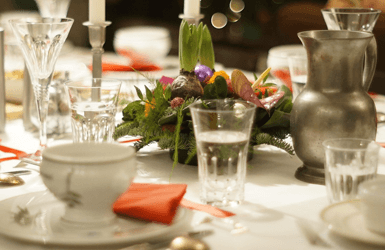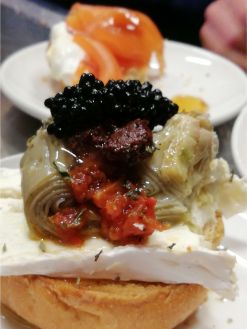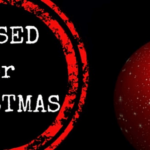
Traditional Spanish Christmas meals: food & menu ideas
BEST TRADITIONAL SPANISH CHRISTMAS RECIPES
If you are here, it can be mainly for two reasons. One is that you’ll be in Spain for Christmas and want to know what are the important Spanish Christmas meals to plan ahead. And two, you are planning a Spanish-themed Christmas meal and need traditional Spanish Christmas food ideas. But in both cases, you are on the right spot! In today’s post we’ll be first discussing what dates you need to consider – you might be surprised to hear that there’s more family Christmas meals in Spain than at home! We’ll also tell you what kind of food is traditionally eaten each day. Then we’ll proceed to give you Christmas dinner and lunch ideas so you can replicate a Spanish Christmas meal at home. Are you ready?
All the traditional Christmas meals in Spain to take into account:

If you'll be visiting Spain in Christmas, you want to be informed of what are the special meals locals celebrate. Nowadays a lot of families prefer to eat out to spare the work of cooking and cleaning, and they make their reservations way in advance. Plus it's not unusual either that restaurants take the day off instead, so their staff can enjoy the holidays with the family. So all this makes it more difficult for you to find a table when you need to eat. And there's nothing more stressful than not finding a place to eat when you are hungry! So these are the Christmas meals to take into account:
- Christmas Eve dinner, the evening of December 24. Most Spaniards celebrate Christmas Eve (although it’s true that for some regions such as Catalonia, the big day is December 25). Locals prepare a large selection of cold and warm appetizers, followed by some soup, and a main course that is usually baked fish or seafood.
- Christmas Day lunch, December 25. While it’s not a widely celebrated family meal, in areas such as Catalonia this is the biggest Christmas meal. After the compulsory selection of appetizers, Catalans eat Escudella soup with galets pasta, and then Carn d’Olla, the rich leftovers of the veggies and meats used to make the soup. Some families will then continue with some stuffed poultry – my family stopped doing that year after year we were too full to eat it.
- San Esteve (Boxing Day) lunch, December 26. Saint Steven’s day is only celebrated in Catalonia and the Balearic Islands, so it doesn’t apply if you won’t be visiting Barcelona or Mallorca. Again, there’s platters of appetizers, that may include also a salad for starter. Then the main course are canneloni – which used to be made with the leftovers of the Christmas lunch meal, but nowadays are done days ahead and frozen or are purchased ready-made.
- New Year’s Eve dinner, the evening of December 31. Locals usually eat at home, with family or friends, getting ready to watch the countdown on TV or head to a local plaza to hear the bells life. That’s why dinner needs to be easy and not take hours to be eaten. Appetizers and finger food are again part of the menu, which usually continues with seafood or baked fish (if the guests aren’t too full from the recent family meals already!). BTW, we have a post about Barcelona restaurants for New Year’s Eve, in case it helps!
- New Year’s Day lunch. Not everyone celebrates this one, because honestly, it’s been so many other meals already by then! But still there’s families who do meet, usually on a small committee, not the extended family. But then…Who wants to cook after a long night out? Many people eat out, what means restaurants are packed (and some may be closed either for lunch or dinner, so plan ahead).
- 3 Kings lunch, January 6. You didn’t expect this one? January 6 in Spain is a huge kid’s day: the Three Wise Men bring them presents! Families gather together to celebrate, so consider it as difficult as the other family lunch days. More appetizers, soup or salad, fish or meat, and then the Roscon de Reyes for dessert!
Spanish Christmas food menu ideas
1
Pica-pica: the appetizers
- Cold cuts. A must. It HAS to include Spanish ham, at least from the Iberico type, but the better quality the better. Then it’s all about your guests’ preferences: chorizo (make it Iberico, too), lomo (cured pok loin), salsichon, fuet… and the more festive galantines and boar head sausages. For more ideas check out our blog post about Spanish charcuterie. And don’t forget some artisan paté or even some foiegrass (I know, that’s French, but if we don’t care you shouldn’t either!).
- Cheese platter. Where there’s ham, it needs to be cheese, too. A good Manchego cheese is a must, but Spaniards also add some Idiazabal, Torta del Casar, Tetilla Gallega, some creamy goat cheese… Spaniards aren’t shy to add French or Italian cheeses to their platters: Tête de Moine, Brie, Cambembert, Parmigiano, Gorgonzola… Some sort of cream cheese served with crackers is also a good idea. Check out our blog post about cheese from Spain for more ideas.
- Veggies. Olives always make a Spanish table, Christmas or not. Actually, for Christmas we go for an assortment of them, not just one type. White asparagus also have their place on a Christmas meal. Then you can throw in some garlicky mushrooms, or baked artichokes, or “escalivada” baked red peppers, onions and eggplant (sprinkle some pink peppercorns on top to make it look more festive). Some veggie spreads such as mushroom paté or hummus (I know, it’s not from Spain but we do it anyways) can be a good idea. Also, in Aragon people serves cardoons with almonds. And if you are looking for some salad idea go for a red tomato salad (choose heirloom or similar, or on the contrary go for grape or cherry ones). Endives with blue cheese sauce will also work.
- Eggs. To be honest, Spanish omelet isn’t elegant enough for a formal Christmas meal, but it’d work fine for an informal New Year’s Eve gathering. For a more festive omelet-related recipe go for an omelet tower instead. Deviled eggs are also a popular Christmas appetizer. And you can also due small skewers with hard boiled quail eggs, cherry tomatoes and mozzarella mini-balls.
- Fish appetizers. Anchovies or “boquerones” (anchovies in vinager). Tuna or cabracho (scorpion fish) spreads. Angulas in garlic – real angulas or baby eels are hard to find even canned, so most locals will sub with “gulas” a fake made of fish paste. Surimi sticks (the only Asian addition to the Spanish Christmas menu). And yet more foreign additions that Spaniards use to add a touch of luxury to their Christmas menu: Smoked salmon and caviar – if you can’t get the real sturgeon eggs, then go for salmon, trout or lumpfish roe instead.
- Seafood. The warm appetizers of any Spanish Christmas dinner, you can go for shells or for crustaceous. Shells include steamed mussels, clams cooked in wine, boiled barnacles (I’m serious, you can check out other weird Spanish foods in my blog, but from all of them only barnacles make the Christmas menu list), baked scallops, grilled razor clams, maybe some sea snails… And for crustaceous locals favor shrimp, prawns, scampi, lobster (langosta or its larger relative “bogavante”), large crabs such as centollo (or txangurro in the Basque Country, similar to king crab) and buey de mar (brown crab) – sometimes you’ll find also just the crab legs, known as “bocas”. Check our blog for more Spanish seafood ideas.
- Other tapas and snacks. The appetizer table gives you the opportunity to be creative. Try some cheese puffs, or some type of croquette (although it might not be such a good idea to go deep-frying right before your guests arrive to find a smelly kitchen…), or a cheese lollipop, or some tartelettes and canapés. I’ve seen other blogs suggesting patatas bravas, but I’ve honestly never seen Spaniards making them at homefrom scratch: it’s a bar thing! But if you like them, you do you!
2
Starters
- Seafood soup. A classic.
- Sopa de galets. Galets are stripped curbed short pasta noodles that Catalans add to the broth of their Escudella de Nadal for Christmas lunch.
- Consomé. Of French origin, it is a flavorful chicken or beef stock, it’s a great option if you are looking for a light starter.
- Sopa de ajo (garlic soup). Served traditionally in Castilla la Mancha for Christmas, you can make it richer by adding grated cheese, grinded hard boiled egg (or a poche egg), bread crumbles…
- Crema reina d’ametlles (almonds soup). Served in the Balearic Islands, its’ made with leek and almonds.
- Sopa de trucha (trout soup). Traditionally eaten in Castilla Leon, it’s a garlic, paprika and trout soup.
- Sopa de picadillo. A soup typical from Andalusia, it consists of noodles, hard boiled egg, Spanish ham cubes and chicken bites.
3
Main courses
Fish and seafood Spanish Christmas mains
- Baked or stewed fish: Spanish people often choose bream, seabass, grouper, turbot, hake and monkfish. Check out our blog post for ideas for Spanish fish recipes.
- Caldereta de langosta. A lobster stew.
- Stuffed baby calamari. Cooked in a thick sauce.
Spanish poultry mains for Christmas
- Chicken: in pepitoria (a traditional sauce with egg yolk, almonds and bread), stuffed and baked with prunes and pine nuts… For Christmas gatherings Spanish people often prefer larger varieties of chicken such as poularde and capon. You’ll find more ideas for chicken recipes in our blog.
- Turkey. Stuffed with prunes, mince meat, nuts…
- Duck: Pato a la naranja (with oranges) or the also sweet and sour Catalan recipe duck with pears.
Spanish meat Christmas main courses
- Carn d’olla. The meat and veggetable leftovers of the broth from Catalan Escudella. It might sound to humble for Christmas, but trust me: it’s so rich!
- Cannelloni. Catalans may serve it as a main course on December 26.
- Cochinillo. Roasted suckling pig.
- Lechazo. Also known as ternasco in Aragon. Roasted lamb.
- Redondo de ternera. The Spanish roast beef.
- And of course you’ll find more Spanish meat recipes in our blog.
4
Dessert
- Turron. The Spanish nougat. There are a lot of different turron varieties, and locals will serve at least 3 or 4 of them, cut in finger-sized portions. BTW, if you are visiting Barcelona, here is where to buy the best turron.
- Mazapán. The Spanish marzipan. The best is made in Toledo, but you’ll find decent ones in cake shops and supermarkets.
- Polvorones y mantecados. Small dry cakes, the size of a cookie but thicker, that crumble in your mouth.
- Barquillos (Neules in Catalan). Traditional rolled waffers.
- Roscon de Reyes (Tortell de Reis in Catalan). On January 6th the other Christmas treats are still served, but in less quantity so people can enjoy a piece of this ring-shaped bread roll stuffed with marzipan or whipped cream, decorated with candy fruit and hiding inside a small figurine of a king and a fava bean. Whoever finds the bean pays for the cake, and the one that finds the figurine is crowned with a paper crown that comes with the cake.
- More Spanish Christmas sweets, of course, in our blog.
5
Drinks
What do Spanish people drink for Christmas? Unfortunately there’s no specific Christmas drink in Spain, and mulled wine isn’t a thing here. So we keep drinking the same we drink over the year:
- Beer goes nicely with the appetizers, but most Spanish people will switch to wines for the rest of the meal.
- Wine is the norm for at least starters and mains, although many people will do wine with appetizers as well. Spanish hosts will often have bottles of both red and white wine, so guests can drink whichever they prefer. In our blog you’ll find our favorite Spanish red wines and Spanish white wines.
- Cava, the Spanish sparkling wine is served for dessert and for toasting. Here you’ll find our favorite Spanish cava brands. Alternatively, in some areas apple cider is served instead of cava.
- Liquors. Some families will end the meal with a shot of some liquor, that is enjoyed during the sobremesa, the long chats that come after a family meal in Spain. We also have a post about Spanish alcohols, of course!
What about coffee?
Coffee and herbal teas are often offered at the end of the meal, after dessert but before the liquors. And it’s mostly a lunch thing, as most people at night prefer not to drink coffee because it interferes with their sleep. However, if you are having dinner at a restaurant the waiter will likely ask you if you want any coffee after dessert. If you need help figuring out how to order your coffee in Spain, guess what? we also have a post about it!
RESEARCHING FOR A TRIP IS TIME-CONSUMING…
Need more inspiration?
Our 100% FREE Barcelona Collection will give you everything you need to organize the trip of your lifetime to Barcelona.
BEST INSIDER TIPS FROM THE PROS!








